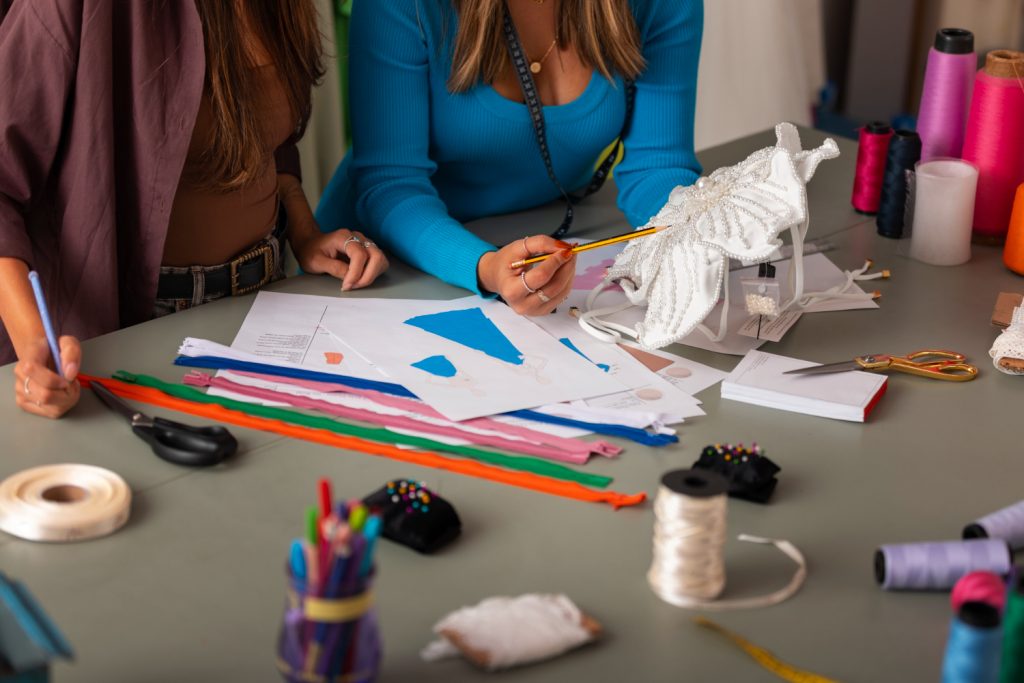Fashion Design Courses After 12th: Course Details, Fee, and Eligibility 2025
This blog is a written guide for students interested in pursuing a career in fashion design after completing their 12th standard. It introduces the fundamentals of fashion design, highlighting the industry’s dynamic nature and the potential for both creative fulfillment and financial success. The blog outlines eligibility requirements for fashion design courses and discusses various educational pathways, including diplomas, bachelor’s, and master’s degrees, with a focus on key areas of study such as fashion illustration and garment construction. It also explores the diverse career opportunities available in the Indian fashion industry, including roles like fashion designer, illustrator, and stylist, while highlighting emerging trends such as sustainability and digital fashion. Additionally, the blog offers advice on selecting the right institution based on factors like faculty expertise and industry connections and answers common questions regarding fashion design education. This resource is designed to help aspiring fashion designers understand the education, skills, and opportunities available in the field.
Choosing a career path after completing your 12th standard can be a monumental decision, especially if you have a penchant for creativity and style. For those inclined toward the world of fashion, a course in fashion design can be a thrilling and promising avenue. In this blog, we will delve into the nuances of pursuing a fashion design course after the 12th, covering course details, eligibility criteria, and the career scope in 2025.
Understanding Fashion Design
Fashion design is more than just sketching beautiful dresses; it is a comprehensive field that combines art, culture, and science to create clothing and accessories. It encompasses a variety of skills from artistic visualization, textile knowledge, trend forecasting, and technical expertise in garment construction.
Why Choose a Fashion Design Courses?
The fashion industry has always been dynamic and ever-evolving, making it an exciting career choice. With the rise of global fashion brands and e-commerce, the demand for professional fashion designers is on the rise. Moreover, a career in fashion design not only promises creativity and fame but also offers the potential for lucrative financial returns.
Read Also: The Ultimate Guide to Y2K Fashion Style & Outfits 2025
Eligibility for Fashion Design Courses After 12th
- Educational Background: Most fashion design courses require you to have completed your 12th standard from a recognized board. While students from any stream can apply, having a background in art or design can be beneficial.
- Entrance Exams: Renowned institutions may require candidates to clear entrance exams like NIFT (National Institute of Fashion Technology) Entrance Exam, NID (National Institute of Design) DAT (Design Aptitude Test), or other similar exams.
- Portfolio: Some colleges might ask for a portfolio that showcases your drawing and designing skills. This is a crucial element for creative courses as it represents your style and capability.
Types of Fashion Design Courses After 12th
- Diploma Courses: These short courses, typically lasting one year, introduce students to the basics of fashion design. They are ideal for those who want a quick entry into the fashion industry without committing to a lengthy program.
- Bachelor’s Degree: Bachelor of Design (B.Des) or Bachelor of Fashion Technology (B.FTech) are four-year undergraduate programs. They offer comprehensive training in fashion design, covering both theoretical and practical aspects, preparing students for professional roles in the industry.
- Master’s Degree and Postgraduate Diplomas: These advanced courses are for students who wish to specialize further after their undergraduate studies. They often focus on specific areas like luxury fashion management, fashion marketing, or textile design, and last for one to two years.
Do you want free career counseling?
Ignite Your Ambitions- Seize the Opportunity for a Free Career Counseling Session.
- 30+ Years in Education
- 250+ Faculties
- 30K+ Alumni Network
- 10th in World Ranking
- 1000+ Celebrity
- 120+ Countries Students Enrolled
Read Also: Design Your Fashion Future with AI: Fashioning a Career in 2025
Key Areas of Study fashion Design Course
Fashion design courses offer a blend of theoretical and practical knowledge. Key subjects often include:
- Fashion Illustration and Design: Students learn to visualize and sketch fashion ideas, both by hand and using digital tools. This foundational skill is crucial for conveying design concepts.
- Textiles: This area covers the study of fibers, fabrics, and materials, their properties, how they’re made, and their applications in fashion. Understanding textiles is essential for creating functional and stylish clothing.
- Garment Construction: This includes learning techniques for sewing, pattern making, and draping, enabling students to transform their designs into wearable garments.
- Fashion History: Students explore the evolution of fashion styles and trends throughout different periods, which helps inform their own designs and understand industry shifts.
- Marketing and Merchandising: This covers the business side of fashion, including how to promote, market, and sell clothing. Skills in this area are critical for anyone looking to start their own fashion brand or work in fashion retail.
Read Also: Different Career Paths in the Fashion Industry in 2025
Book Now →
Fashion Design Career Opportunities and Salary Expectations in India
- Fashion Designer: In India, fashion designers are the creative backbone of the industry, crafting clothing, accessories, and footwear to meet both trends and individual client demands. Starting out, fashion designers can expect to earn between INR 3 to 6 lakhs per annum. As they gain experience and build a reputation, their earning potential increases significantly, often reaching up to INR 12 lakhs annually or more. This is especially true for those who work with well-known brands or launch their successful fashion labels.
- Fashion Illustrator: Fashion illustrators in India play a critical role in visualizing and depicting fashion designs and concepts. They typically work on a freelance basis, making their earnings quite variable. Annual salaries can range from INR 2 to 5 lakhs, depending on the volume and prestige of their work. Those who secure contracts with leading fashion magazines or luxury brands can command higher fees due to their exposure and the quality of their work.
- Fashion Stylist: Fashion stylists in India are tasked with creating eye-catching outfits for photoshoots, celebrity appearances, and advertising campaigns. They collaborate closely with designers, photographers, and celebrities to ensure that the final look meets the creative vision. Starting salaries for fashion stylists can range from INR 3 lakhs per annum, with potential earnings exceeding INR 10 lakhs for those involved in high-profile projects or working with celebrities.
- Pattern Maker: Pattern makers are indispensable in the Indian fashion industry, turning designer sketches into practical patterns ready for garment production. They need a solid understanding of fabrics and mastery in cutting techniques. Beginners in this field can earn between INR 2.5 to 4 lakhs annually, while seasoned pattern makers working for prestigious brands can make upwards of INR 6 lakhs, reflecting their expertise and the complexity of their work.
- Fashion Merchandiser: Fashion merchandisers in India are involved in analyzing market trends, purchasing materials and products, and crafting marketing strategies. They play a crucial role in connecting the production team with the market. Entry-level merchandisers might start with salaries around INR 3 lakhs per year, escalating to INR 8 lakhs or more for those in senior roles at larger retail chains or luxury fashion brands.
These career paths in the Indian fashion industry not only offer ample opportunities for creative expression but also vary in terms of financial rewards. The pay reflects an individual’s role, level of experience, and the company’s market presence. As the fashion sector in India continues to expand, these roles provide promising avenues for both career growth and personal fulfillment.
Read Also: A Delhi Girl’s Journey to Stardom: Avanti Nagrath
Fashion Designing Course Fee India
In India, aspiring fashion designers can pursue a variety of programs, including diploma, certificate, and degree courses. The cost varies depending on the program type and institution. Certificate and diploma programs typically range from ₹10,000 to ₹300,000, while undergraduate degrees can cost ₹200,000 to ₹1,200,000 per year. Prestigious institutions may have higher fees. Thorough research is recommended to find the program that aligns with your budgetary constraints and design aspirations.
Do you want free career counseling?
Ignite Your Ambitions- Seize the Opportunity for a Free Career Counseling Session.Emerging Trends in Fashion Design
In 2025, sustainability and technology are leading the way. Designers are increasingly adopting eco-friendly practices and integrating AI into their design processes. Additionally, the digital fashion space is expanding, with opportunities in creating virtual clothing for online platforms.
Read Also: Gen Z Fashion Trends 2025: A Fashion Guide (Updated)
Choosing the Right Institution for Fashion Design
When selecting a college or university, consider factors like faculty expertise, infrastructure, industry links, and internship opportunities. Institutions with a robust placement cell can significantly enhance your career prospects.
Conclusion
A course in fashion design can open doors to a vibrant and exciting industry, offering numerous opportunities for creative expression and professional growth. As the fashion landscape continues to evolve, equipped with the right skills and knowledge, you will be well-prepared to make your mark in this glamorous field. Choose wisely and take the first step towards a rewarding career in fashion design. The AAFT School of Fashion offers various programs tailored to students eager to dive into the fashion world. Explore our diverse courses to find the program that best fits your aspirations.
FAQs
What qualifications do I need to enroll in a fashion design course after 12th?
Most fashion design courses require you to have completed your 12th grade from a recognized board. While students from any stream can apply, having a background in art, design, or home science can be advantageous.
Are there any entrance exams for fashion design courses?
Yes, some top institutions like NIFT and NID require you to pass entrance exams such as the NIFT Entrance Exam or the NID DAT. These exams assess your creative aptitude and skills relevant to fashion design.
How long does it take to complete a fashion design course?
Diploma courses usually last one year, while Bachelor’s degrees are typically four years long. Master’s degrees and postgraduate diplomas can vary between one to two years, depending on the program’s focus and structure.
What are the key subjects studied in fashion design courses?
You’ll study fashion illustration and design, textiles, garment construction, fashion history, and marketing and merchandising. These subjects cover both the creative and business sides of fashion.
What are the latest trends in fashion education for 2025?
Sustainability and digital fashion design are emerging trends. Courses now increasingly focus on eco-friendly practices and the use of technology in design, like 3D printing and virtual reality.

AAFT has been providing the world with limitless creativity and expression since 1993! Through a dynamic and industry-driven curriculum, AAFT provides engaging and captivating articles to persuasive blogs and empowers its readers to explore diverse avenues of creative media education-related content.











